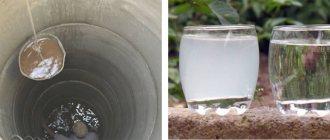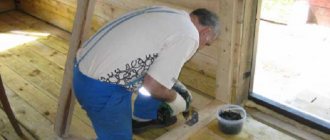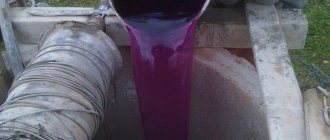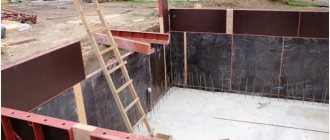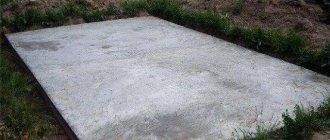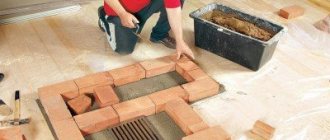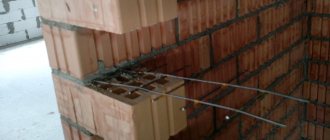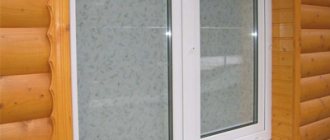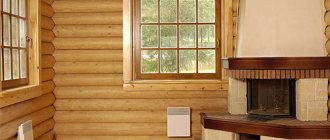Sectional view of a well
Since a reinforced concrete sewer well is often used to make joints and turns, and this requires a tray of one design or another, the requirements for the latter are clearly regulated.
It is made of concrete; the angle of rotation, if provided, cannot be less than 90 ° in relation to the flow of drained water.
In this case, the tray must have a smooth rounding with a radius not less than the diameter of the larger pipe, and if the pipeline diameter is 2000 mm or more, then five diameters.
On the sides of the tray there are shelves or working platforms with a slope of 2% towards its center, located in height at the level of half the diameter of the larger pipe.
If necessary, the wiring inside the tray is additionally reinforced with halves of ceramic pipes of the appropriate diameter.
If a reinforced concrete sewer well has a diameter of incoming pipes of 1.5 m or more, then the working area must be fenced, and brackets must be provided for lowering and lifting into the well (except for networks containing acidic juices).
The standard depth of the well is determined to be 1.8 m, but in general it depends on the depth of the pipeline.
Established Standards
Also, a round hatch diameter of 700 mm, or a rectangular one, with sides of at least the same size, is provided in the well ceiling.
In general, there is GOST sewerage wells, No. 8020-90, which establishes standard dimensions of elements for mines.
The following abbreviations apply:
Depending on the purpose, on what series of sewer wells is provided for a given type, they can have the following dimensions:
Type of device
| Series | D internal | D ext. | Ring height H | |
| KFK and KDK | KDK10 | 1000 | 1160 | 1270 |
| KFK10 | 2410 | |||
| KFK13 | 1250 | 1410 | 2630 | |
| KFK15 | 1500 | 1680 | 2870 | |
| KFK20 | 2000 | 2200 | 3110 | |
| KLV and KLK | KLV8 | 820 | 960 | 1550 |
| KLK10 | 1000 | 1160 | 1800 | |
| KLK13 | 1250 | 1410 | ||
| KLK15 | 1500 | 1680 | 1980 |
Lattice storm sewer hatch
In this case, GOST allows the height of the rings to be increased to 1790 mm in increments of 300 mm. Neither SNiP nor GOST for reinforced concrete sewer wells regulate the volume as such - but there are requirements for a well height of 1800 mm, with a depth of less than 1.2 m the diameter of the well can be 1000 mm, and with a depth of 3 m or more - from 1500 mm or more.
Wells for storm drainage can be equipped with a standard size lattice hatch, which allows for the function of catchment (KLV series).
At the same time, the location of the hatch also has its own requirements: it can be installed flush with the surface on asphalt or concrete roads, it must protrude from the surface by 5-7 cm in the green zone, and by 20 cm in undeveloped areas.
Also, if necessary, hatches are equipped with locking devices.
Water supply sources
Sources of water supply can be surface and groundwater. The waters of the soil layer and the perched water (the so-called waters of the aeration zone) are fed mainly by atmospheric precipitation and are retained on waterproof layers impenetrable to them. These waters have an unstable flow rate (the number of liters of water per hour) and are susceptible to pollution, therefore they are usually not used in water supply.
Gravity groundwater, usually associated with the surface waters of rivers, seas and lakes, is replenished by precipitation at some distance from the place of its intake and can be used for domestic and drinking needs. These waters have a low flow rate, are also susceptible to pollution and require special attention to the organization of a sanitary protection zone. To obtain free-flow groundwater, shaft wells are used, made of stone, concrete, reinforced concrete, wood, into which water enters through the bottom and walls. Water in wells is installed at the same level as in the aquifer.
Equipment process
Since reinforced concrete sewer wells are prefabricated structures, installation of such sewer wells requires installation and concrete work.
Well with a rectangular base and ceiling Well ring with a bottom
First, a base - a round or rectangular slab - is lowered into the prepared pit.
The size of the base is determined by the diameter of the rings used.
There are also rings in which the base is pre-made as a single unit with the product.
It is clear that such a part is used only as the bottom of a well.
This allows you to improve the waterproofing properties of the device.
The required height of the well is selected based on the standard sizes of the rings; for precise adjustment to the required dimensions, standard additional rings with a height of 10, 15, 20 and 30 cm are used.
However, when installing networks, they always try to reduce the number of parts to a minimum in order to simplify installation and avoid unnecessary seams - they do not benefit the tightness of the structure.
It is mandatory to waterproof sewer wells if groundwater occurs above the bottom of the well.
In this case, the level of the insulating layer must be at least 0.5 m higher than the primer level.
Since the well always provides for the passage of a larger or smaller number of pipeline branches, corresponding holes are punched in some of the rings (in the case of an inspection shaft - in the lower one, in the case of organizing a drop - maybe in others).
As a rule, this is done in advance, since doing them in a ring installed in a pit is not very convenient.
A sand cushion with a thickness of at least 100 mm must be installed under the base slab, and the horizontal position of the slab itself must be strictly verified.
If a reinforced concrete sewer inspection well is installed, a tray is made of cement in it according to the rules set out above.
All parts that make up the structure are also held together with cement. Since all components have mounting loops, if these embedded parts interfere with the installation of the following elements, they are bent or cut off.
After installation of the structure, the pipelines are sealed with cement, and, if necessary, the connections are waterproofed.
Why are additional rings needed?
When it is impossible to install conventional ones, additional rings are used for the well. They solve problems caused by the width, slope or height of a standard through-hole. The height of the additional ring is less than 40 cm, so it allows you to bring the shaft to the desired height if this is not possible with a regular one. From a specialized company, you can order additional rings based on individual measurements so that they exactly match the structure being built.
When designing a well, much attention is paid to the decorative component. Rarely do owners agree to simply have a head sticking out on the property, covered by a hatch
For such cases, the upper rings with a beautiful relief are cast.
Installation locations
In accordance with the requirements of SNiP, reinforced concrete sewer inspection wells are installed in accordance with the following standards:
Drop structures are installed to change (increase or decrease) flow speed, reduce the depth of sewerage, or at intersections with other communications.
At the same time, regardless of the type of well, the main requirement for it is to ensure reliable protection of the pipeline from mechanical and other damage.
For this purpose, reinforced concrete sewer wells, when installed in traffic areas, are additionally strengthened and, if necessary, equipped with expansion joints. This eliminates the transfer of weight loads to the pipes.
Source
Storm drainage system
When laying a concrete ring or polymer chamber, a sand and gravel cushion is created. If the well is sealed, a concrete slab is laid under it and everything is coated with bitumen. Or the drainage pad is made thicker. Even at peak loads, the storm drain must cope with the flow of water, so grates and sand traps are needed. The drop well will take the brunt of the water, so a metal sheet is needed there. This will prevent the body from collapsing.
If a plastic system is preferred, it installs faster. When installing 2-3 wells, you can choose plastic, although concrete rings help save on purchases. However, the savings are outweighed by the light weight of the plastic and ease of maintenance. It is up to the customer to decide which material to choose.
Construction of a sewer well
Sewer wells are a mandatory attribute of external sewerage; without them, its installation is impossible. They must run along the entire length of the pipeline. Their design and quantity may vary slightly, depending on the type and purpose of the structure, complexity and length of the system.
The process of constructing such a device is not complicated, the main thing is to understand the difference in types of structures, because a homemade septic tank or cesspool is also a well, and to comply with the rules and requirements. After this, it will be easier to make an efficient and trouble-free sewage system for your home.
Captages of springs
Groundwater is divided into pressure (artesian) and non-pressure. They can emerge on the daytime surface. In this case, they are called springs. The outlet of free-flow water is called a descending spring, and the outlet of pressure water is called an ascending spring. Spring water has an excellent taste, high quality and can be used for drinking purposes without purification.
To collect such water, springs are captured using capture chambers. To capture water from rising springs, chambers are installed to receive water through the lower part of the chamber. To increase the water intake surface, capture is carried out in the form of horizontal water intakes made from reinforced concrete, concrete or ceramic pipes with round or slotted holes. To prevent soil particles from being washed out by water into water intakes, they are sprinkled with filtering sand and gravel media.
To prevent the entry of polluted surface runoff into water intakes, a clay cushion is placed on the surface of the earth under the water intakes. The simplest horizontal water intake can be made from short pipes with gaps at the joints, from brick or rubble stone without the use of mortar. To inspect and clean horizontal water intakes, inspection wells are installed every 50–150 m along their length.
Water is taken from the ascending spring (see Fig. 5) through the bottom of the capture chamber, and from the descending spring (see Fig. 6) through the holes in the chamber walls.
Rice. 5. Device for capturing an ascending spring
Requirements
The requirements for sewer wells are regulated in SNiP 2.04.03-85. This act describes all aspects relating to these structures: location, classification, dimensions and characteristics. The document says that a well is installed if:
Overall dimensions may vary. depending on the diameter of the pipeline:
| ∅ pipe (mm) | Dimensions (mm) |
| up to 150 | 700 |
| up to 600 | 1000 |
| up to 700 | 1250 |
| from 1000 | 1500 |
| from 1200 | 2000 |
The volume is not indicated, but knowing the depth and diameter you can calculate it yourself. The operational characteristics of concrete wells are reflected in GOST 8020-90, and plastic (polymer) wells in GOST 32972-2014.
Video: Sewerage made from concrete rings is the simplest and cheapest option
Also, when installing a well shaft, it is necessary to comply with sanitary standards, these include:
You can read more about sanitary standards in this article: Rules for installing a septic tank.
Design Features
Wet wells come in different types, but they all have the following elements:
- a shaft, which is considered the basis of the structure and is often cylindrical in shape;
- a neck that acts as a load-bearing element (if the well is located in a pedestrian area, it may not be used);
- sewer hatch - they cover the top of the drainage well and through it they gain access to underground communications;
- bottom (sediment consisting of silt or sand and other suspended particles collects here).
Wells have different depths and are made of different materials; most often concrete or plastic are used for these purposes, although brick structures are also found.
Types of wells
To understand which and how many wells need to be installed on the site, you should understand their types. The sewer system may include the following types:
Each of them has its own specific function; sometimes they can be combined in one structure. Below we will take a closer look at each of them.
Lookout
Perepadny
Serves to change pipe laying depth or flow rate. They can also be used to bypass any obstacle. The design consists of a tank with inlet and outlet pipes located at different heights, and additional devices, for example, stages for reducing speed. Just like the previous view, they may differ slightly from each other:
Filtration
These models are used as a device for soil post-treatment of wastewater coming from a septic tank. The design feature of this well is the absence of a bottom and holes in the walls. Instead, a drainage layer of crushed stone or gravel is installed at the bottom and outside of the well.
Cumulative
A place for collecting and storing wastewater, in other words, an ordinary cesspool. When arranging it, it is important that the container is sealed and cleaned regularly.
Types of well rings
Well rings can be made of two materials:
- Concrete.
- PVC.
Peculiarities:
- Both have excellent properties and characteristics. They are widely used for the construction of water supply wells.
- With them, the process of constructing a structure is quite simple and all actions are completed very quickly.
Types of concrete rings
The ring for a concrete well is made from:
- Concrete mortar.
- Fittings.
- Various additives that increase its strength and environmental friendliness.
At the moment there are several types that are used for arrangement:
- Supporting.
- Wall.
- Additional ones.
- Castle ones.
- With a bottom.
- Tongue-crested.
More details:
- Support rings for wells are needed if a hatch will be constructed in the future. They are installed in front of the floor slab and can ensure reliable fastening of the hatch.
- Wall rings for wells are ordinary ones, which are installed on top of each other during the construction of the well. All joints must be filled with concrete mortar to ensure their reliable fastening.
In their design, additional rings for wells are the same as wall rings, only they have non-standard sizes. They are used to provide the required depth. They are installed at the very beginning of the wells below and the wall ones are already attached to them.
- Castle wells are very similar to ordinary concrete wells. Their main difference is that they have a special lock. They are also called tongue-and-groove. In addition to the lock on the upper part, there are special ridges on the lower part. The design, which is assembled from this type of rings, is distinguished by its strength.
- There are also certain holes that are filled with concrete during installation. All of them, when securely fastened, are not capable of horizontal shifts. Reinforcement also takes part in their production, which gives them greater strength.
- Rings with a bottom are not particularly complex in their design, since they are made like wall rings, only they are additionally equipped with a bottom. Accordingly, during construction they are laid on the bottom of the structure and serve as a support for it.
- There are also adjustment rings for wells. They are used to increase the depth of the well in the range of 50 cm. This allows you to obtain cleaner water. They are made of reinforced concrete or PVC.
The photo shows all the types that are used in water supply structures.
Installation of a plastic well
Ready-made containers made of plastic or other polymeric materials make it possible to complete all work without the involvement of lifting equipment and save time. The main thing is to choose the right location for the structure and its size. Installation is carried out in several stages:
To avoid filling a well of any type, it is recommended to make a concrete blind area around it along the entire perimeter of the neck, 1.5 m wide.
Video: Installation of a sewer well made of concrete rings
Source
What does a well consist of?
Basically, above-ground and underground elements are distinguished. The depth of the well should allow filtration to be installed.
Main parts of the well:
- Header. Represents the upper ground part. The element performs a protective function to prevent runoff and precipitation from entering the source. The head structure includes a roofing part, a blind area, a canopy and a lifting structure. To decorate the head, you can use wood, stone, or plaster. A mechanism is provided outside for draining rainwater.
- Shafts of hydraulic structures. This is the space between the head and the bottom. The design has a casing. The main purpose of the element is to protect concrete rings from destruction.
- Water intake part. Used to store water. There the liquid is filtered and settled.
The well consists of above-ground and underground elements.
The water intake part includes a casing and a filter. In this case, the design can be incomplete, complete or with a sump. In the incomplete version, the column does not reach the water layer and approaches from below.
The incomplete design is simple to implement and has a large volume of water.
The full version is more complex in design, where the casing rests on a layer of waterproof rocks. The part with the sump has a water reserve depth of 1.5 meters. Suitable for large quantities of liquid.
Lookout
To maintain and monitor the sewer pipeline, inspection wells are installed along its entire length.
The distance between them depends on the diameter of the pipes used when laying the main line: the larger the pipe, the greater the distance between the wells.
So for pipes with a bore diameter of 50 mm, the distance along a straight section must be at least 35 meters, for pipes with a diameter of 200 mm - at least 50 m, and for pipes with a diameter of more than 2000 mm, the distance from well to well must be at least 300 meters.
Such wells are installed at junctions with the central sewer network, in places where the pipeline changes its direction, and where the movement of wastewater depends on the design of the tray in the sewer well.
Photo: inspection wells
In the manufacture of inspection wells, the same materials are used as in other engineering sewer structures - reinforced concrete rings, bricks, etc.
The structure itself is a round or rectangular shaft, at the bottom of which an open type tray is installed. Through it, wastewater from one pipe smoothly flows into another.
The entire underground structure is covered with a round or square slab in which a hatch is installed. Depending on the depth of the well, metal brackets are mounted on its inner wall for ease of maintenance.
Photo: metal brackets for maintenance The distance between them should not exceed 350 mm vertically. An open tray allows you to monitor the speed of wastewater flow and simplifies the procedure for cleaning a section of the sewer line in the event of a blockage.
Photo: plastic inspection wells If necessary, the components of the well are replaced with parts and assemblies of suitable length and configuration.
Briefly about the occurrence of groundwater
The purpose of building a well on a suburban area is to open an aquifer capable of covering the family’s needs for drinking or industrial water. The first is used according to its name, the second is used for watering the area, cleaning and similar needs.
It is necessary to decide on the drinking and technical category at the planning stage of future production, because its depth and design depend on this. Categories differ according to the degree of pollution. The chemical composition of process water contains more mineral impurities, odor and slight turbidity are allowed. Drinking water must be crystal clear, completely devoid of smell and taste.
Rocks in the earth's crust occur in layers, within which the soils have equivalent physical and mechanical properties and the same structure
Aquifers are layers of rock of equivalent composition and structure that contain groundwater. On a geological section, they appear as strips of arbitrary width, lying at an angle or relatively horizontally.
The upper boundary of the formation is called the roof, the lower is called the base. Depending on the thickness of the aquifer and the required amount of water, the well can only penetrate the roof, cross 70% of the formation, or be installed with its bottom on the base. The roof of the aquifer, in turn, serves as the base of the overlying layer, and the base serves as the roof of the underlying layer.
There are two natural ways for water to appear in rock strata:
- Penetration of atmospheric precipitation or water from nearby bodies of water into soils. Water passes freely through permeable sediments, which include sand, pebbles, rubble and gravel. The process of seepage or penetration is called infiltration, and layers that allow water to pass through are called permeable layers.
- Condensation of moisture in layers sandwiched between two waterproof or otherwise impermeable layers. Clays, loams, semi-rocky and rocky rocks that do not have cracks do not allow water to pass through. The water lying between them can be under pressure: when opened, its level rises and sometimes gushes out.
Fractured rock and semi-rock varieties can accommodate water, but there is no pressure or it is weak. The chemical composition of fissure water will certainly be influenced by the host rocks. Limestones and marls will enrich it with lime, dolomites with magnesium, gypsum steamed with rock salt will be saturated with chloride and sulfate salts.
Groundwater is formed as a result of infiltration of precipitation or water from neighboring reservoirs and as a result of condensation within the formation
Water permeability and water resistance are two very important characteristics for those who want to know how to build a full-fledged well with their own hands, because:
- The presence of impermeable rock above the aquifer prevents the seepage of dirty wastewater into the formation. Water extracted from an aquicluded layer can be classified as drinking water.
- The absence of an aquifer on top of the water carrier signals that the use of water for drinking purposes is prohibited. It is called perched water and is used exclusively for household needs.
If the owner of the site is interested in the technical category, it is quite enough to open or go deeper into the layer with perched water. The well shaft in such cases is much shorter than the drinking water shaft. True, the mirror of the perched water can hardly be called stable. During dry summers and winters, the level in such mines is lower than during rainy autumn and spring periods. Water supplies will fluctuate accordingly.
Strata that are capable of releasing water when opened by a mine are called aquiferous; rocks that do not transmit or release water are called waterproof or waterproof.
To obtain a stable amount of water in the well, the perched water must pass and go deeper into the underlying aquifer. Usually there are several permeable and waterproof layers between it and the perched water. This means there is a possibility of reaching drinking water. However, the trunk of such a well is much longer: it will take more material, time and labor effort to build it.
Important. Drinking water must be tested by the local sanitary and epidemiological authority. Based on the analysis results, conclusions are drawn about its suitability. If necessary, cleaning measures are recommended.
Turning
The function of an inspection hydraulic structure is also performed by a rotary well. The only difference from the direct-flow analogue is the trays with different flow directions, as well as the installation location: 90° turns and other changes in the direction of the sewer pipe.
Photo: types of rotary wells
Since turns of the main pipeline by more than 45° are predisposed to the occurrence of various types of blockages, control over these nodes must be appropriate.
The installation of a brick sewer well includes:
The base of the well lies on the same level as the passing main, so the tray is of an open type and is made in the form of a smooth turn in the direction of flow.
To make it easier to clean sediment and eliminate possible blockages, wall brackets are used. In this case, the diameter of the well must be at least one meter, for the convenience of descent and work of a person.
Regardless of the depth of the sewer line, products made from modern materials - plastic wells - can be used.
This is an almost finished product, with inlet and outlet openings for pipes and a tray for the passage of drains.
Photo: plastic rotary wells
The entire process of installing plastic prefabricated wells occurs very quickly, and the material used in production is durable and does not pose any threat to the environment.
Installation of concrete well rings
All work related to the installation of concrete structures must be performed with special equipment. Likewise, the installation of reinforced concrete rings for a well should be carried out using mobile cranes. Work order:
- Additionally, rubber inserts and concrete mortar are also used, which help to more reliably seal the structure and thereby increase its service life.
- The installation process itself depends on what types have been selected. If the walls have a bottom, then they are the first to be laid and only then the subsequent ones are placed on them.
Tongue-and-groove structures shorten the construction process, as they have their own specific fastenings and are quite firmly fastened together. And if their joints are coated with concrete mortar, the structure will last for more than fifty years.
Construction of a filtration well: functions, diagram, device
A well designed to filter wastewater is installed in the sewer system after the septic tank.
Its task is to accept wastewater that has undergone preliminary treatment and then pass it through a layer of soil, which, in this case, acts as a filter.
Most often, this water treatment element is installed if there is no possibility of draining wastewater into the central sewer network or underlying soils.
Photo: filtration well
1. Manhole cover 2. Exhaust pipe 3. Neck body 4. Insulating cover 5. Supply pipe 6. Outer gravel layer 7. Well body 8. Shield 9. Internal filter layer
Important! When planning a site for a filtration well, it is worth considering the distances to nearby buildings and wells for drinking water (according to SNiP this is no closer than 10 and 30 meters, respectively).
It does not matter what shape the filtration structure will have, but if it is planned to construct a sewer well from concrete rings, then something like a foundation is made along the perimeter of the base.
The rings from which the well is constructed must have holes through which the filtered moisture will flow out.
Photo: sewer well made of concrete rings. Gravel, expanded clay, broken bricks and other material with a fraction size of approximately 10 to 70 mm are poured inside the well.
Outside, along the entire perimeter, bedding is made from the same composition as inside the well, but not more than 1 m. The supply pipe should be approximately 15 cm above the filter layer.
Important! To prevent erosion of the bottom filter, a wooden shield, pre-treated with an antiseptic compound, is placed under the stream of water.
What types of rings are there for a drinking well?
There is no single standard that regulates the sizes of rings for wells. To line a well shaft, rings with an internal diameter of 90-100 cm and a height of 70-100 cm are used. These values are dictated by practicality: if you take less, it will be inconvenient to dig inside, if more, the amount of manual labor will increase significantly. The larger the ring, the heavier it is, which means additional shipping costs.
Concrete rings, indistinguishable from the outside, differ in casting technology and composition:
- Drinkable;
- Sewer;
- Gas pipelines.
The most stringent requirements are imposed on water intake rings. Each ring must have a standard marking. Before going on sale they are subjected to production tests.
You need to order reinforced concrete rings only from certified sellers. Under the guise of well products, you can unknowingly buy simple technical ones, which contain harmful impurities
High-quality reinforced concrete rings have many advantages:
- Lowest price (in comparison with a wooden frame or rubble masonry);
- Solidity;
- Easy to install and repair;
- Resistance to soil pressure;
- Wide range.
For strong and durable well concrete rings, a frame made of reinforcement is used, filled with a mortar of M-500 cement. The wall thickness is from 10 cm.
When producing rings for non-food purposes, casting molds are lubricated with petroleum products. Along with them, an oil film may appear in the new drinking well, which is not easy to get rid of.
In industrial production, vibration is used to compact the solution in the molds, but the surface of the finished ring retains some porosity, so it is impossible to completely clean it of oil.
Cumulative
This is practically the largest well in size, which accepts the discharge of all domestic wastewater. Most often, it is installed within suburban households, closer to the boundaries of the site, which makes it possible for the sewer truck to freely approach.
According to regulatory documents, structures of this type must have a concrete bottom and waterproofed walls.
Such a well can be made of various materials. The design of reinforced concrete sewer wells depends on the size of the rings and the estimated depth of their location.
The concrete used for the manufacture of rings must be waterproof (grade W4), and its density must comply with SNiP (“.03.01-84”).
Photo: storage well made of concrete rings. A ready-made concrete slab is installed at the bottom of the pit. The rings are mounted on it using a crane. For better fixation of well rings, they are fastened together. Then the entire structure is covered with a slab with a hole for the hatch.
Photo: covering a well with bitumen
Internal joints are sealed with sand-cement mortar, and the outside is covered with bitumen to eliminate possible leaks.
Of course, you can make a storage well yourself. An excellent material for this is brick. The entire process of constructing a well occurs after installing the base: the bottom of the pit is filled with concrete.
And here it does not matter what shape the future structure will be, round or rectangular. The main thing is that the walls of the well are strong and without cracks.
The outside of the masonry is insulated with roofing felt and tar. The floor slab for the pit is made of concrete, but directly on the well itself.
Photo: brick storage well
Sewage system equipment made of plastic or fiberglass is considered more modern and less labor-intensive. Having a long working life, wells made of these materials are increasingly used in the form of storage tanks.
Photo: plastic storage well
The installation procedure does not require special equipment - a container is lowered into the prepared hole, adjusted in depth, then connected to the sewer pipe. The well is filled with soil without large stones, while the manhole cover is left in sight.
Important! All storage wells, regardless of what material they were made from, must be located at a distance of at least 10 meters from the foundations of buildings. It is also not recommended to plant trees near wells, with the exception of shrubs with a small root system.
The table below shows prices for some types of sewer wells and their components.
The correct functioning of the entire drainage system depends on the material of the product, as well as on the quality installation of sewer wells.
This means that the installation and maintenance of sewerage hydraulic structures must be carried out by people with experience in this field, without fail observing all safety standards and using personal protective equipment.
There are open and closed types. They are used for the purpose of separating sewage waste; with their help, heavy fractions and large debris are separated from water. These open-type structures are a reservoir that is assembled from perforated concrete blocks. In them, the liquid goes into the ground on its own through special holes. Heavy fractions remain in the mine and are removed using special equipment for further disposal.
Closed-type installations are a special sealed container that has technological outlets located at different heights. When wastewater enters the mine, floating particles are discharged using the upper channels, and sediment layers are discharged using the lower channels.
The structure must be installed in a place where groundwater lies below the station bottom level. Additionally, a 0.5 m cushion of crushed stone is poured in. The base should rise 1 m above the soil.
Conclusion
Before you start setting up a sewage disposal network, be sure to read all the provisions of SNiP, start planning, marking, and then selecting a mine that suits you. You will definitely need an estimate for the installation of a sewer well in order to correctly calculate in advance all the costs of arranging the entire highway network.
What is a sewer well, for what purposes is it used and what needs to be taken into account when choosing it? These questions are relevant to this day, since without a full-fledged wastewater and waste disposal system, comfortable living in a country house is out of the question.
In order for the external sewage system in a country house or cottage to be efficient and reliable, it must not only be installed correctly, but also selected correctly. In this article we will look at what a sewer well built on the basis of concrete rings is.
The choice of such a design is not accidental, since, despite the fact that polymer and plastic analogues appear on the market, it is the reinforced concrete structure that is installed everywhere outside the city.
Concrete rings for wells
The main advantages of well rings are their durability, frost resistance and resistance to soil movement. Unlike plastic septic tanks, concrete wells are not at risk of fracture or aggressive action from wastewater components. Nevertheless, there are disadvantages of concrete rings for wells and sewage systems:
- The impossibility of manual transportation, which significantly increases the cost of installing concrete rings for sewerage or a septic tank as a whole. The cost of sewerage can be reduced by making it from other types of material that are inferior in quality and longevity, but nevertheless do not require special financial costs.
- The large size and weight of concrete rings is indispensable without the use of loading assistance. Sometimes the cost includes delivery of products, but you need to clarify this in advance. In addition, if the production is located miles away from the installation site of the well sewage system, then it makes sense to think about an alternative.
- The use of reinforced concrete well rings leads to cracks on the surface and corrosion of the reinforcement - structural fatigue, a significant nuance in the sewerage system. In addition, if a used concrete ring was used, the production was carried out in an artisanal way, or low-quality binder was used, then the well will crumble quickly and the sewerage system will become unusable.
Products in the form of concrete rings for sewerage or a septic tank in a summer cottage are divided into numerous parameters. In connection with this, they differ in various characteristics, sizes and conditions of use. For example:
- Classification of sewerage systems by type of construction. Concrete rings can be straight or with locking connections. The first are a simple cylinder shape, secured with staples and cement mortar. The latter have a protrusion and a notch on the edges, respectively. Thanks to this structural well effect, horizontal or vertical displacement of the sewer well and septic tank is impossible.
- According to the form. Concrete rings also exist in square shapes. They are used mainly for installing highways, but if you want to install a sewer system with them, there is no problem. The only inconvenience is that the size of the reinforced concrete products and their weight do not allow the use of a small area of soil. For the covers, special reinforced concrete floors with double-level hatches are used to provide insulation - the products themselves are cold, and freezing of the sewage system cannot be allowed.
- By fittings. Well rings can be equipped with bottoms and covers. This sewerage design will not allow the smell of sewage to escape into the atmosphere, and will not pose a danger in terms of the flow of feces into groundwater or nearby drinking sources. The manufacturer offers combined septic tanks, then installation will take place in the shortest possible time.
Correct selection of the size of concrete rings and the weight of related products will allow the sewer system to last for a long time
To determine the dimensions, it is important to take into account many factors - from the number of people using the sewer system to the soil conditions and climate of the area
Classification according to purpose
The sewer well is used to organize turns, pipe drops and other elements as part of the sewer system.
In accordance with their purpose, wells are divided into the following types:
Let's take a closer look at each of the listed types.
In the photo - a rotary inspection well
Using this structure, you can inspect the pipeline for blockages and, if necessary, clean it.
The height of a drop-type well is no more than 4 meters. This limitation is explained by the need for a gentle impact of falling water, since falling water from a greater height over many years can lead to the destruction of the entire structure.
Important: Before going down into the shaft of a water-sewage well, you must make sure that the air pollution is normal and there is no content of potentially dangerous gases. To make measurements as accurate as possible, a gas analyzer for sewer wells is used.
Design features
The sewer system well consists of three main structural elements:
Important: If the diameter of the pipeline is 30 cm, meter rings for the well are used, at the same time the manhole should not be less than 70 cm. When using pipes of a larger diameter, a standard bottom with a diameter of 1 meter cannot be used. For proper installation, we punch a hole of the required diameter in the bottom.
Not so long ago, wells were built exclusively using brick and concrete. The process was labor-intensive, which negatively affected the cost of the system as a whole. In addition, the structures built in this way were not the most durable and required periodic repairs.
Ineffective technologies have been replaced by industrially manufactured reinforced concrete structures. The cost of sewer systems built using reinforced concrete has become an order of magnitude more affordable, and the service life has increased significantly. And most importantly, the implementation time for sewerage construction has been reduced significantly!
Sewage systems of various configurations and varying degrees of complexity can be assembled from reinforced concrete structural elements. This is largely due to the fact that reinforced concrete products have clear standard values, and the range of such products includes dozens of different modifications from which one can choose one or another option.
The elements of sewer wells include the following reinforced concrete products:
By the way, similar components are used for the construction of reinforced concrete wells for heat and water supply.
Using the listed reinforced concrete parts, it is possible to create standard sewer wells for various communications used in the transportation of household and industrial liquids. An important advantage of reinforced concrete wells is the simplicity and efficiency of waterproofing.
Important: Despite the fact that reinforced concrete sewer wells can be used everywhere without any significant restrictions, in permafrost conditions these structures are irrelevant. Therefore, in the northern regions one should resort to the use of other technologies.
In accordance with operational requirements, two types of reinforced concrete elements are produced:
It can be used if the geological and hydrogeological conditions of the area are suitable for this, and there is no danger of contamination of water supply systems and soil. The need to use such structures arises when it is impossible to connect to the central networks of the city.
Construction of a sewer well as a septic tank
For example, a septic tank designed for a capacity of 1 m 3 per day should have dimensions of 1x1.5 m, the depth of the tank will be 2.5 m. According to the standards, the distance from the house to the septic tank should be from 5 to 20 meters, and the drainage network is laid like this so that wastewater does not erode the foundation and cannot cause flooding of the basement.
It should be noted that it is best to install round sewer wells (septic tanks). The walls must be at least 25 cm thick. The pipe through which sewage water will flow from the house to the septic tank should be installed 5 cm above the pipe intended for drainage into the drainage system. Tees must be installed on the inlet and outlet pipes of the septic tank through which water will flow. The upper part of the tees is open, and the lower ends, together with their pipes, should be approximately 40 cm below the approximate water level in the septic tank. Ventilation of septic tanks is carried out using an internal sewer riser, discharged above the level of the roof of the house.
Types of wells and their placement
Before chatting about how to build a well with your own hands at the dacha or on the site of a country house, it is worth determining about their varieties. The following types of structures will be able to participate in the sewerage system:
- Inspection or control well. It is installed on straight and long sections of sewer pipe lines. Using the inspection well, the operation of the system is monitored and the pipes are cleaned if necessary.
- Turning. When designing a sewerage system, it is undesirable to make turns, since it is in such places that the possibility of blockages is high. But bending can't be avoided from time to time. In this case, rotary wells are constructed.
- Nodal. If it is necessary to make a branch or connect several sewer systems, junction sewer wells are built.
- Drops. If the site has a complex terrain, then in some areas there may be a strong difference in the level of pipe laying. To avoid this, drop wells are constructed.
- Storage and filtration. Such structures are the end points of sewer systems. They collect all wastewater for future cleaning or disposal.
The location of the structure will depend on its purpose. If a nodal, differential and rotary well is built in accordance with the sewerage scheme, then the inspection and storage well must be located in accordance with existing standards. The inspection well must be placed at a distance of no less than 3 and no more than 12 meters from the pipe exit from the house. In addition, the distance between them should not be more than 15 meters. A storage or filtration well is built far from sources of drinking water. So, in accordance with SNiP, the distance to the well from which they take it should not be less than 30 meters. Also, there must be free access for vehicles to the storage well. It is necessary to periodically pump out the accumulated sewage using a sewage truck.
In particular, it is necessary to pay attention to certain parameters.
Independent hydrogeological surveys
To find out the level of groundwater in a site, the most reliable, but labor-intensive and expensive method is test drilling. In private construction it is rarely used, because the cost of services of professionals using special devices is high.
If there are wells in neighboring areas, you can ask how deep they are, whether the water in them is suitable for drinking, and whether they dry up in the summer. You can find out the composition of the soil and assess the reality of doing excavation work on your own (it is difficult or impossible to dig a mine in hard and medium soils). Sometimes, after a survey, it turns out that in order to ensure an autonomous water supply, it is necessary to drill a well to artesian waters.
If it was not possible to obtain information about the level and quality of groundwater from neighbors, then you have to carry out independent research. You can try traditional methods (a frame made of a willow branch, determination by vegetation on the site, etc.).
Where to install a water supply facility
Choosing a location for an individual water supply source is not very easy, especially if a small area is already occupied by impressive residential and commercial buildings. It is important to take into account that, even if you want to save meters, when planning a place to build a personal well with your own hands, it is recommended to adhere to the following rules:
- A drinking well should not be located near manure heaps, latrines, bathhouses, cesspools, barnyards and similar objects. There should be at least 20 - 25 m between the well and the source of probable contamination.
- There is no need to build a well on the slopes of river banks or ravines. Due to the decreasing flow of underground water, the flow rate will be significantly reduced.
- The minimum distance between the well and the foundation of a house or utility block must be at least 5 m. Water currents will be directed into the well, like into a reservoir formed in the ground, washing away the soil from under the foundations, particle by particle. The corner of the building located nearby will certainly sag.
Ponds with standing water are considered an undesirable neighborhood. Water will certainly infiltrate through permeable rocks, which is extremely dangerous for the drinking category.
According to sanitary standards, the distance from the well to the specified objects should be at least 20 m, ideally 50 m
It is prohibited to locate a well near sources of biological and chemical pollution, not preferably on slopes, near ravines and on river banks
Sewage well as a filter
If the house is located on sandy or sandy loam soil, and does not produce more than 1 m 3 /day of liquid waste, then a filter well is well suited. It should be noted that filtering decks are installed not only for the sewerage system, but also for drainage of the area; in this case, perforated pipes drain excess water into it.
A filter made of crushed stone, gravel, boiler slag and other similar materials should be installed at the bottom of the well. The height of such a filter is from 0.5 to 1 meter. Inside the walls, the wells are covered with cement mortar. The outer walls and base of the filter well must be covered with the same material that was used as a filter. In the diagram below there is a septic tank: a filter well is used in addition to the cesspool.
Sewer stairs KL-1
We produce ladders for sewer wells of any size at the customer's request.
| Type of stairs | Length (m) | Price |
| KL-1-2.0 | 2,0 | 2430 |
| KL-1-2.5 | 2,5 | 2955 |
| KL-1-3.0 | 3,0 | 3480 |
| KL-1-3.5 | 3,5 | 4000 |
| KL-1-4.0 | 4,0 | 4530 |
| KL-1-4.5 | 4,5 | 5000 |
| KL-1-5.0 | 5,0 | 5570 |
| KL-1-5.5 | 5,5 | 6110 |
| KL-1-6.0 | 6,0 | 6650 |
The price list shows average prices including VAT and delivery.
When building modern drinking wells, special reinforced concrete rings are used. To prevent the work from being delayed, they are immediately brought to the site and unloaded near the place chosen for digging the well. The exact quantity that will be required to construct the mine becomes known only after the aquifer has been found.
Manufacturing materials
The following materials are used in production.
Polymer
Polymer wells are the most common variations of such devices. Some users use unconventional methods for their production, which involve the use of automobile rubber. This method is considered the simplest and least expensive. However, such a solution is not airtight and has a long service life.
Plastic
Plastic is the simplest and most durable raw material for constructing wells. There are ready-made polymer models on sale; you can also create such a structure with your own hands. This will require the use of a corrugated pipe and a plastic plate. Construction requires little investment along with certain skills. Advantages of plastic:
- small weight;
- high level of reliability and strength;
- replaceability of the bottom tray;
- all elements are sealed;
- You can order a container of any size.
Flaws:
- high price;
- specified placement depth;
- Often plastic is a non-separable product.
Collapsible models are endowed with versatility, since the depth can increase or decrease. Most often, plastic wells are used as rotary or inspection structures. However, due to their tightness, such structures can be used instead of a water collector. Liquid is pumped out using a pumping station.
Reinforced concrete
Reinforced concrete is a classic material for sewerage installations. Construction is made from concrete rings with further treatment of all joints with sealant. Such cesspools are highly functional. The advantages include the following criteria:
- universal characteristics;
- long service life, which exceeds 50 years;
- quick installation;
- high strength indicators;
- reliability of the material;
- affordable price category.
Flaws:
- large mass;
- installation will require the use of a winch and other special equipment.
Such tanks are often used as inspection structures when the pipeline is located at a significant depth. Thanks to high-quality sealing, concrete products can play the role of water collectors.
Here, too, it is not difficult to obtain an unknown quantity. For example, you need to find the height of a well.
Dimensional rulers, work on arrangement of wells
According to SNiP, sewer wells must have the following dimensions:
- Pipelines with a diameter of up to 150 mm - at least 70 mm;
- Diameter up to 600 mm – from 1000 mm;
- Diameter size up to 700 mm – from 1250 mm;
- Diameter 800-100 mm – from 1500 mm;
- With a diameter of 1500 mm and above and a depth of 3 m and above are subject to individual consideration.
Volumes are not separately regulated; everything must be calculated from the depths and diameters specified on the diagrams. As for the work, the general cycle includes preparatory actions, installation and completion.
- Layout or marking of the territory, according to construction rules;
- Clearing the area of bushes and vegetation;
- Demolition/relocation of interfering buildings. The impossibility of action is stipulated by special standards;
- Preparation and arrangement of the entrance and road to the construction site.
Arrangement and installation of a standard sewerage structure, preparatory work according to SNiP:
- Excerpt from the pit;
- Cleaning the bottom;
- Reconciliation with the project in terms of ground level, wall slope angles;
- For stone structures, arrangement of a waterproofing bottom layer, as shown in the diagram or plan (layer of at least 20 cm), subsequent compaction.
All preparatory work has been completed and the next stage is installation.
Stone wells
The steps and actions are:
- Preparation of the base involves laying a slab or arranging a cushion of M-50 concrete 100 mm thick;
- Arrangement of a concrete tray reinforced with steel mesh (M-100) of the required shape;
- Sealing the end holes of the pipeline with concrete and bitumen;
- Creation of an insulating layer of the internal cavity of the rings of the structure;
- Installation of the rings occurs only after the tray has gained strength (2-3 days), then the floor slab is laid. The solution used for work is M-50;
- Sealing joints with cement mixture;
- Waterproofing with bitumen;
- Mandatory plastering of the tray with cement, followed by ironing;
- Installation of clay joints at the entry point of the pipe/pipes with a width of at least 300 mm and a height of 600 mm greater than the diameter of the pipeline.
Subsequent testing work takes place within 24 hours and includes complete filling of the structure with water with the pipeline being blocked with temporary plugs. If no leaks are detected, the well walls are backfilled, a blind area measuring 1.5 m is installed, the joints are insulated with a hot bitumen mixture - the work according to SNiP is completed, the system can be put into operation.
The installation schemes for brick structures are practically the same as concrete ones, but instead of aligning the rings, they are laid out with stone. Waterproofing work is completely identical. In this way, stone wells of any type of sewerage system are installed: domestic, industrial, stormwater or drainage. But each design has its own nuances:
- The storm drain is equipped with lattice hatches that have a drainage function;
- Drainage wells themselves are drainage systems, so installation does not require special calculations.
Differences in configuration are determined by the series:
- KFK/KDK - domestic wastewater;
- KLV/KLK – storm drain;
- KDV/KDN – drainage wells.
The size table gives a complete picture:
Drop wells
A more complex configuration determines the volumes and SNiP requirements for differential wells. In addition to arranging the tray, you need to do the following:
- Installation of risers;
- Have water pumping equipment;
- Install a water wall;
- Create a practical profile;
- Set up a pit.
Otherwise, with regard to the installation of the shaft, base, floors - the rules are the same as the previous ones.
Important! The exception is a riser drop well - it requires installation of a metal pipe at the base, which will prevent the destruction of the concrete structure.
The diagram looks like this:
- Riser pipe;
- Waterproof pillow;
- Metal base (plate);
- Receiving funnel (riser).
A funnel is required for compensatory discharge processes formed in the riser due to the rapid movement of flows. Do-it-yourself creation of drop-off wells in private areas is not recommended, unless it is a pipeline with a diameter of 60 cm and a level difference of up to 3 m, but such pipes are practically not used in individual systems, and are successfully replaced by other types of wells. SNiP requirements for drop-off wells are simple, installation is recommended in the following cases:
- It is necessary to significantly reduce the depth of the pipeline;
- If there are intersections with other underground utilities;
- Adjustment of wastewater flow rate is necessary;
- In the case where the well is the last one before the direct release of wastewater into a river or lake.
The same reasons can serve as a reasonable justification for installing a drop well on your own property.
The next stage is the transition to the construction of the mine. Wells made of concrete are assembled in a zero pit, where working elements have not yet been installed.
